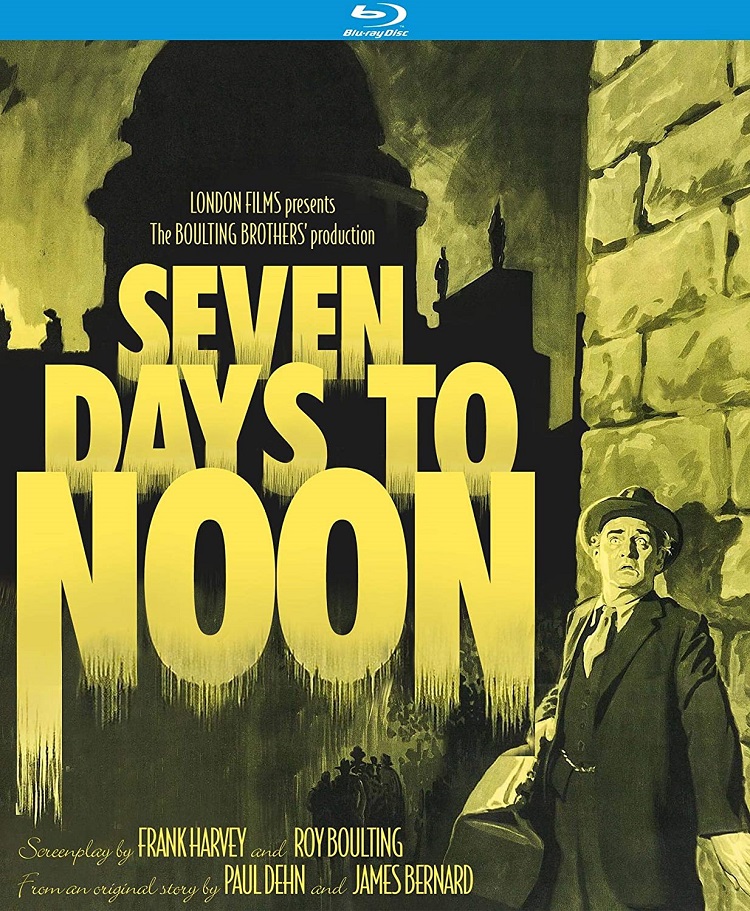
The atomic bomb not only helped win World War II and fueled the Cold War for years after it, but it spurred our cultural imaginations and fears for decades to come. It spawned a huge wave of nuclear monster movies from Godzilla to all sorts of giant insect monsters and deadly amorphous blobs. Science-fiction films in the 1950s and beyond often relied on nuclear energy to create its deadly foes. There were also plenty of much more serious dramas like Sidney Lumet’s Fail-Safe about the potential of nuclear disaster.
Released in 1950, Seven Days to Noon is a British drama that delves into the fears of a nation over a nuclear bomb exploding on English soil and lingering memories of The Blitz during the Nazi years. It is often cited as a thriller but save for a few moments in the last act things aren’t particularly tense. It is, however, a very good drama.
Professor Willingdon (Barry Jones) is an English scientist who has spent his career working on military weapons, and the last several years developing nuclear bombs. Realizing that his life’s work has been spent finding better ways to kill people in mass quantities, he snaps. He steals a small bomb and sends a letter to the Prime Minister declaring that if the English government doesn’t renounce nuclear weapons and stop its production within one week’s time, he will set the bomb off in the middle of London. Detective Superintendent Folland (André Morell) is charged with stopping this from happening. The film follows Willingdon, as he hides out waiting for either the declaration from the Prime Minister or the time to explode the bomb, and Folland, as he attempts to track and stop Willingdon.
When Willingdon sees a picture of himself in the newspaper, he shaves his mustache and rents a room from a dotty old lady, Mrs. Peckitt (Joan Hickson). She calls the cops on him after he spooks her pacing about his room in the wee hours of the night, suspecting he might be the landlady killer she’s read about in the papers. Later, when things heat up for him on the street, he comes back to her flat locking her in with him. Meanwhile, Folland has officers scouring the city while the government debates when and how to tell the populace of the threat. With the clock ticking, they make an announcement on television and start a massive evacuation.
In many ways, the film works as a procedural. It meticulously follows Folland as he systematically tries to find Willingdon. When the evaluation is called for, it walks us through that procedure from the transportation vehicles being assigned numbers to the people lining up to get on the train. We see all sorts of animals being taken away from people because there isn’t enough room. We follow the police as they go from home to home making sure everybody has left. I have no idea if that’s how they would actually do such a thing, but it feels very real. Mostly because the film takes the time to show us how it works. This might not sound like very interesting cinema, but it is quite compelling.
Numerous times ordinary citizens comment on how it all feels like it did back during the war, or how they haven’t seen an evacuation like this since Dunkirk. When the announcement is made detailing what is happening, the film lingers on the faces of regular folks at bars and places of work, visualizing what must have been a very real fear at the time.
Towards the end of the movie after the evacuation, hundreds of policemen circle around the large area in which they suspect Willingdon must be and they systemically move from place to place searching every corner for him. Several times we see officers grow bored from the tedium. One fellow is caught drinking down in the underground. Two men almost miss finding Mrs. Pickett because they don’t want to walk upstairs to check those rooms. So much of the film is devoted to the details of how such a terror would affect the populace.
It is in the last ten minutes or so that real tension begins to heat up. The clock does start to tick and it gets ever closer to noon, the time in which Willingdon said he would detonate the bomb. The people desperately look for him and we see numerous close-ups on the soldiers and policemen looking worried. His daughter is brought into speak some sense into him and it really does feel like the bomb might just go off. It’s all handled really well, giving the film a conclusion and some much-needed thrills.
Seven Days to Noon is a film not so much about the ticking of the clock or the white-knuckle experience of a thriller, but of how such situations affect your average citizen. How the government would behave under such a threat in order to save as many as it can. If you come in expecting an edge of your seat thriller, you’ll be disappointed. But for what it is, it is quite good.
Kino Lorber Studio Classics present Seven Days to Noon with a 1080p transfer and an aspect ratio of 1.37:1. Extras are slim, only an image gallery and several trailers are included.